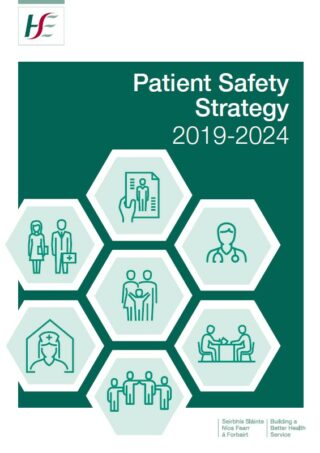As Assistant National Director in the Health and Safety Executive (Ireland) National Quality and Patient Safety Directorate, I lead a number of strategic programmes including the Patient Safety Programme, the National Medication Safety Programme, QPS Improvement, and the National Centre for Clinical Audit.
Patient safety has been a central priority for me throughout my career. From my youthful days as a student nurse, right up to my current role as a senior manager in the HSE, I’ve been a champion of quality and patient safety.
The HSE Patient Safety Strategy

The HSE Patient Safety Strategy (2019-2024) was launched in December 2019, giving emphasis to the many excellent patient safety initiatives directed at making our health service safer for patients and staff.
Soon after its publication, however, our health care system experienced monumental change.
The COVID-19 pandemic and a major cyber-attack increased challenges for clinical teams, with safety and communication complications coming to the fore. The last two years, however, have also been a shining example of our health care system’s flexibility, adaptability and resilience as we adapt to the “new normal”.
Our Patient Safety Programme Team was established in mid-2021 to act as a central hub for information, learning, networking and resources to facilitate services to achieve a shared vision of patient safety.
A Shared Vision for Patient Safety
The concept of a “shared vision” of patient safety is critical to me. Working both through and with others is imperative for achieving such an important goal.
We use a programmatic approach to address the commitments of the patient safety strategy broadly and methodically, using QI and project management to underpin our work. We guide services on ways to pivot from reactive to proactive, and take opportunities to collaborate across services and programmes.
Working in partnership with patients is essential to our approach. The insights and experience they share with us guide our decision making and ensure patient safety is at the heart of everything we do.
I am proud of the excellent work that is happening in our National QPS Directorate and right across the HSE. I am grateful for the continued teamwork and support of colleagues and patients in bringing our many improvement projects and programmes to fruition, and working towards a shared vision for patient safety our health service.
Reducing Medication Related Harm
This year, the focus of World Patient Safety day is “Reducing Medication Related Harm.” The safe and appropriate use of medication is important across all parts of our health service. It is an issue which affects all of us in our work, and in our own lives, as health care professionals and as patients.
Our National Medication Safety Programme is working closely with patients and health care professionals to reduce harm associated with medicines or their omission.
One of our projects, iSIMPATHY, is an EU-funded project led by the Scottish Government in partnership with the HSE and Northern Health and Social Care Trust. It highlights effective ways to undertake medication review for people who take multiple medicines. The “Know Check Ask” medication safety campaign encourages people who use regular medicines to know more about their medicines and to ask their pharmacist, doctor or nurse if they have questions.
World Patient Safety Day events programme
To mark World Patient Safety Day on 17 September, our National QPS Directorate has launched an awareness campaign that includes webinars, podcasts, media campaigns and informational videos.
For two weeks, we’re holding a range of events focusing on patient safety. These include Medication without Harm, an online symposium delivered jointly with the State Claims Agency. We will also hold events addressing topics including incident management, psychological safety, and offer QPS learning opportunities.
Please visit our website for details about our National QPS Directorate World Patient Safety Day programme of events. We welcome you to join our engagement activities.
Finally, speaking of engagement, I would like to acknowledge our valued relationship with the Q community.
What an opportunity it is to work with like-minded professionals across our five nations; actively engaged and striving for similar goals to progress improvement efforts to address high risk patient safety areas.
I look forward to exploring how we can be more systematic in developing our association with Q going forward, as I can see the far-reaching benefits of this alliance.